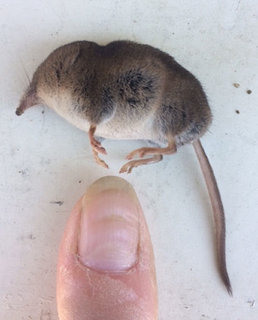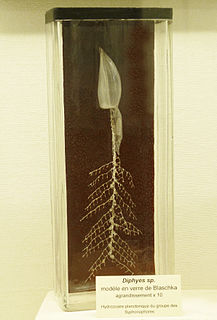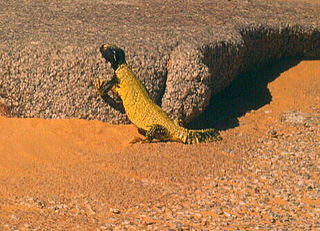
Lymantria dispar, sometimes known as the gypsy moth, is a species of moth in the Erebidae family. Lymantria dispar is subdivided into several subspecies, with subspecies such as L. d. dispar and L. d. japonica being clearly identifiable without ambiguity. Lymantria dispar has been introduced to several continents and is now found in Europe, Africa, Asia, North America and South America. The polyphagous larvae live on a variety of deciduous and coniferous trees and can cause severe damage in years of mass reproduction. Due to these features, Lymantria dispar is listed among the world's 100 most invasive alien species.

True thrushes are medium-sized mostly insectivorous or omnivorous birds in the genus Turdus of the wider thrush family, Turdidae. The genus name Turdus is Latin for "thrush". The term "thrush" is used for many other birds of the family Turdidae as well as for a number of species belonging to several other families.

Ichthyornis is an extinct genus of toothed seabird-like ornithuran from the late Cretaceous period of North America. Its fossil remains are known from the chalks of Alberta, Alabama, Kansas, New Mexico, Saskatchewan, and Texas, in strata that were laid down in the Western Interior Seaway during the Turonian through Campanian ages, about 95–83.5 million years ago. Ichthyornis is a common component of the Niobrara Formation fauna, and numerous specimens have been found.

Cherax, commonly known as yabby/yabbies in Australia, is the most widespread genus of fully aquatic crayfish in the Southern Hemisphere. Various species of cherax may be found in both still and flowing bodies of freshwater across most of Australia and New Guinea. Together with Euastacus, it is also the largest crayfish genus in the Southern Hemisphere.

The large copper is a butterfly of the family Lycaenidae. L. dispar has been commonly arranged into three subspecies: L. dispar dispar, (single-brooded) which was commonly found in England, but is now extinct, L. d. batavus, (single-brooded) can be found in the Netherlands and has been reintroduced into the United Kingdom, and lastly, L. d. rutilus, (double-brooded) which is widespread across central and southern Europe. The latter has been declining in many European countries, due to habitat loss. Currently L. dispar is in severe decline in northwest Europe, but expanding in central and northern Europe.

Camptosaurus is a genus of plant-eating, beaked ornithischian dinosaurs of the Late Jurassic period of western North America. The name means 'flexible lizard'.

Ichthyornithes is an extinct group of toothed avialans very closely related to the common ancestor of all modern birds. They are known from fossil remains found throughout the late Cretaceous period of North America, though only one species, Ichthyornis dispar, is represented by complete enough fossils to have been named. Ichthyornitheans became extinct at the Cretaceous–Paleogene boundary, along with enantiornitheans, all other non-avian dinosaurs, and many other animal and plant groups.

Philodromus is a genus of philodromid crab spiders. Spiders in this genus are distinctively flattened.
Shorea dispar is a species of tree in the family Dipterocarpaceae. It is endemic to Borneo, where it is confined to Sarawak.

The Starhead topminnow is a native United States species that ranges from the Ouachita River drainage in Louisiana, the Big Black river in Mississippi, and extends northward into the Mississippi River and Lake Michigan basins to the southern Michigan and southern Wisconsin areas. The Starhead topminnow is endangered due to the removal of aquatic vegetation and the continued development of land that infringes on its habitat.

Lymantria dispar asiatica, formerly known as the Asian gypsy moth, is a moth in the family Erebidae of Eurasian origin. It is similar to Lymantria dispar dispar in appearance, but adult females can fly. It is classified as a pest and is host to over 500 species of trees, shrubs and plants.

Lymantria dispar dispar, commonly known as the gypsy moth, European gypsy moth, or North American gypsy moth, is a species of moth in the family Erebidae that is of Eurasian origin. It has a range that extends over Europe, Africa, and North America.

Lymantria dispar japonica, formerly known as the Japanese gypsy moth, is a moth in the family Erebidae of Eurasian origin.

The Arabian toothcarp is a species of killifish belonging to the family Cyprinodontidae. It can be found from the shores of the Red Sea south to Ethiopia, the Gulf of Aden, the Arabian Sea and along the Persian Gulf east to Pakistan and India. It is also found in the Suez Canal, the northern coast of the Sinai Peninsula, and in one location on the palestine coast. There are two recognized subspecies: A. d. dispar found throughout the range, and A. d. richardsoni, the Dead Sea toothcarp endemic to the Dead Sea.

The long-tailed shrew or rock shrew is a small North American shrew found in Atlantic Canada and the Northeastern United States.

The Diphyidae are a family of siphonophores. These are colonial siphonophores with two nectophores arranged one behind the other. The front one includes a somatocyst, while the hind one does not. The somatocyst often contains an oil droplet for buoyancy control. A nectosac in each nectophore allows the organism to swim efficiently.

Xyleborus dispar is a species of Xyleborus.

Uromastyx dispar, the Sudan mastigure, is a species of agamid lizard. It is found in Mauritania, Sudan, Chad, Western Sahara, Algeria, and Mali.

Hibbertia dispar is a species of flowering plant in the family Dilleniaceae and is endemic to eastern Australia. It is a prostrate to low-lying shrublet with hairy, linear leaves and yellow flowers arranged on the ends of branchlets, usually with four to six stamens in a cluster on one side of two carpels.
Diphyes is a genus of hydrozoans belonging to the family Diphyidae.
















